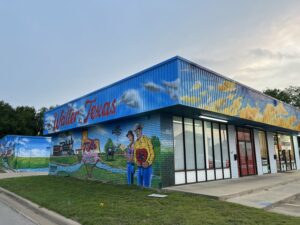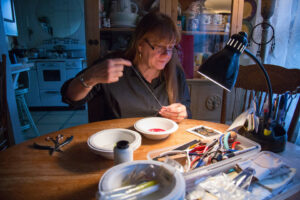A muralist fights for free expression and economic liberty in Texas

The visionary artist Andy Warhol once said, “Everything has its beauty, but not everyone sees it.” It’s true: Art that dazzles the senses for one may not excite another. But thanks to the freedom of expression recognized by the First Amendment, even if someone cannot see the beauty in art, they have no right to censor it.
Yet, in the small town of Waller, Texas, a new city ordinance has stripped artists of their First Amendment rights and robbed them of their livelihood.
The most interesting man in America
To say muralist Brad Smith is a fascinating man would be an understatement. Brad is not one to brag of his own accomplishments, but his wife, Kay, is delighted to do it for him. Within just a few minutes of talking with the couple, Kay chimes in, eager to share stories of Brad’s unique adventures, like the time he helped Elvis’s lead guitar player get into the Rock & Roll Hall of Fame—thus creating the “sideman” category—or the time in the ’90s when he had to take the rapper Vanilla Ice to court. (At this point Brad nonchalantly adds: “He called me a couple of months ago and everything’s fine.”)
Brad has been painting murals since he was 15 years old, a skill that was born out of a punishment he received when his school sent him home for getting in trouble. So as not to waste time sitting around the house, Brad’s father made him help paint a mural for the local church. He would later attend art school in Chicago, and 46 years later, what started as a punishment is now his life’s passion and his career.
Many talented artists never figure out how to translate their creativity into an income. In fact, some even take pride in living the broke and bohemian lifestyle. But not Brad. He was never keen on being a starving artist. An entrepreneur at heart, he saw a path forward that would allow him to do what he loved and get paid for it.
When he returned to Texas after school, he missed the colorful murals that surrounded him in Chicago. Seeing a void in the market, he made a name for himself across the state as a muralist. His work helped spark the art culture in his home of Deep Ellum in Dallas and Fort Worth’s Near Southside district.
Later, he and Kay started Tilt Vision Art—a business where art and entrepreneurship collide.
Brad explains that the origins of the name came from the building that housed the original Tilt Vision gallery.
“It’s one of those concrete buildings,” he says. “It’s made with a tilt wall where they pour concrete on the walls and that’s how they make the building. So it was always known as the Tilt Building. So we made it the Tilt Gallery.”
But the name is multi-layered.
“My son’s a filmmaker, so we called it Tilt Vision. So Tilt Vision sounds like television, but it also is how you tilt your head when you look at art sometimes.”
Tilt Vision sells original artwork, painting beautiful murals for clients with the ultimate goal of making art accessible to everyone.
“Our goal is to democratize art,” Kay says, “to make it accessible to the public where they may not ordinarily go to a gallery or go to the museum to see it. We really want to bring it to the masses.”
But there is another aspect to their business that makes Tilt Vision unique. Brad and Kay are strong proponents of art-based economic development.
Brad noticed that where his murals were painted, economic development followed. “In downtown Dallas,” he explains, “my friend opened a bar in an old warehouse as artists do, and we had big parties and everything. But then a coffee shop would open up next to my mural and then another bar, then another restaurant, until now, there’s 200 bars and restaurants in this one neighborhood.“
He continues:
I decided after that, “Hey, let’s move out to the country and see if I can do this art thing in a little rural town.” Now, that one took about 30 years to get really booming. Dallas took five years and it was booming, and the city came in, the mayor begged us. They were asking us, can we change the roads? We had them put streetlights all in to redo this whole neighborhood. And now Uber has their headquarters there and it’s a really big deal.
At the end of 2022, Tilt Vision had a huge opportunity. Brad and Kay had secured a commercial contract with Finishes Solutions, a real estate development and construction firm based in Waller, Texas. Not only was the contract financially promising, it would give them leads that would help further expand their business. They packed their bags and set off on their Waller adventure.
The small town that banned art
With a population under 3,000, Waller sits halfway between Dallas and Houston and is the epitome of small-town living.
Waller is the poster child for a small town resistant to change; the kind of town you see in movies like Footloose or Pleasantville. Years earlier, the city had even fought tooth and nail to prevent the construction of a high-speed rail that would go from Dallas to Houston. The older generation of residents want to keep things the way they always have been; that’s probably why the town has had the same mayor for over 30 years. As Kay commented, “They don’t want change. They don’t understand it’s coming anyway.”
When Tilt Vision set to work on the 13 murals Finishes Solutions had hired them to paint, they ran into a problem. A long-time Waller resident complained to the city council that the colors used to depict clouds and the night sky were “too bright.” The resident then asked the city council to restrict the creation of new murals—a proposal that the city unfortunately adopted.
The new city ordinance bans murals on commercial building fronts, murals used as advertisements, and those containing any type of “commercial messaging”—that is, logos, written references to a business’s products, and even possibly their depictions. Other citizens are banned from placing murals with personal, religious, or cultural messages on a commercial building if the building owner charges a fee. Additionally, each new mural must be registered with the city and the artist must pay a hefty $500 fee before starting work.
Imagine being so offended by bright colors that you ask the government to ban art. Brad explains that murals must use bright paint in order for them to last:
The reason I paint them extra bright is so they last long. I put a lot of color in there, intense color, because the sun in Texas especially fades, and by five years it’s back to a normal color. But I beefed the color up in the beginning, and then they fade naturally and by 10 years they look almost perfect.
Tilt Vision had completed only three of the 13 murals they were hired to paint when the ordinance was passed. When Finishes Solutions caught wind of the new regulations, they suspended their contract with Tilt Vision—indefinitely. This dealt a huge financial blow to Brad and Kay’s business.
It’s not like the entire town was against the murals. When the mural celebrating the 75th anniversary of the town was finished, residents and local police officers came with smiles on their faces to take pictures. But the joy the murals brought to the townies wasn’t enough to change anyone’s mind. The resident who complained said something to the effect of “not everybody likes art.”
The ordinance has robbed the town of beautiful art and Tilt Vision of their livelihood. And it’s not just Brad and Kay who will suffer.
Brad’s emphasis on embracing the entrepreneurial spirit within his art is a big part of Tilt Vision. The company has about 11 artists who work with them. Mural painting is quickly becoming a lost art, and by taking these artists under his wing, Brad also is keeping the tradition alive.
“There aren’t really many people with 46 years of mural painting experience,” he says. “In fact, I’m trying to teach a bunch of young people how to do it professionally so that they can make a living and make sure their murals last 10 years.”
But thanks to the city council’s ban on murals, these artists have lost a major opportunity to hone their craft and earn a living.
The ban is absurd, no doubt. But it’s also illegal.
You can’t ban creative expression
Governments—whether federal, state, or local city councils—cannot restrict a person’s right to free expression. Under the First Amendment, artists like Kay and Brad are free to express themselves creatively, regardless of any resident or city council member’s personal opinions about their murals.
If a government is allowed to ban a mural they do not like, what is to stop them from banning books, or music, or even speech?
As artists, Brad and Kay understand what is at stake and they are ready to take a stand. Together with Pacific Legal Foundation, the pair is fighting back against the town of Waller to restore their First Amendment rights.
Sure, they could move, but having just relocated to Waller to fulfill their contract, picking up and moving doesn’t seem like an option.
“The thought of moving away from here crossed my mind,” Kay says. “But we have four rescue horses. Moving is no easy feat. And like Brad said, we spent half a million dollars on this place to move here because we thought we were going to be here working for at least two years, if not more. So no, I’m not going to let them silence us, bully us, and run us off.”
Kay adds, “I don’t back down from bullies ever, ever. In my growing up, I was bullied mercilessly and got beat up a lot, almost every day. And so I just can’t walk away.”
Plus, they feel they have a duty to protect other artists.
“I know it’s bigger than us,” Kay says. “This is much bigger than us. And I’m looking down the road here for future artists and future business owners and it pisses me off.”
“Creativity takes courage,” French visual artist Henri Matisse said. He probably meant the courage to express your deepest emotions—but it also takes courage to fight back against small-town government bullies.
“I don’t like backing off when somebody pokes me and rubs me. It just seems to me like it’s a lot of control; to tell a business owner what they can do with their building, and me as an artist, what I can paint,” Brad says.
For Brad and Kay, protecting the rights of all artists is the most important aspect of this case, and Pacific Legal Foundation will be by their side to help them in their fight.
“Defending the First Amendment is the main thing,” Brad says. “How can they tell us what we can say? My opinions are speaking to a direct medium, to the citizens. There’s no in-between. “






